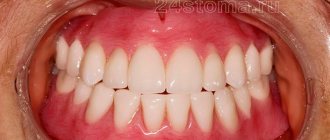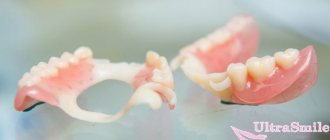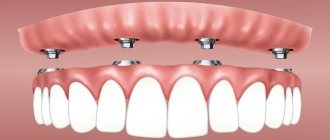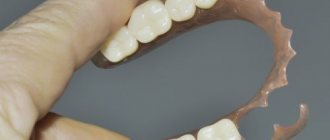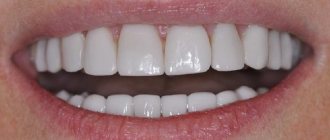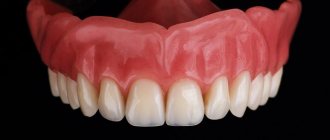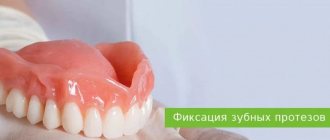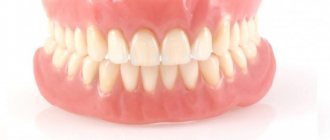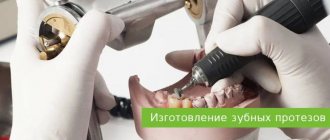The loss of even one tooth in a row can lead to serious negative consequences for the health of the oral cavity as a whole, so it is necessary to solve the problem and restore lost dental units immediately. To restore lost teeth, modern dentistry offers different types of procedures - prosthetics and implantation. The greatest demand among patients is for more affordable prosthetics, which can involve both fixed and removable types of dentures.
In terms of durability and strength of fixation, the best option would be fixed dentures, but their installation is not always possible, and then removable dentures can help restore the beauty of your smile. However, such orthodontic structures are available in a wide range, and sometimes the patient finds it difficult to choose a specific type of product for prosthetics. This article is designed to help you find out all the useful details about removable dentures, and we will start with a detailed overview of all existing types of removable dentures.
Removable dentures: definition and classification
Orthodontic products for prosthetics can be either removable or non-removable. The key difference between the designs is that by choosing a removable denture, you can always either remove or put it on without the help of a specialist. Removable dentures have their own gradation into individual varieties, which is important to get acquainted with - this will help you make the right choice of a specific type of product. First of all, you should know that there are separate types of removable dentures for complete and single restoration.
How to choose a prosthesis?
It is quite obvious that the aesthetic characteristics of more expensive designs will obviously be higher, even taking into account everyone’s subjective assessment. Of the objective factors that will help you choose a prosthesis in the absence of teeth, there are two:
The first is medical indications. If the bone is very thin, it may not be possible to place implants without bone grafting. If the patient is aged, then such operations are carried out solely with an eye to the state of health. Mini implantations and conventional prostheses are often used.
The second is the patient’s requirements for the cost of treatment. This factor plays the greatest role in drawing up the final treatment plan.
Dentures for restoration with complete edentia
Complete restoration of the dentition is necessary when all teeth have been lost and a complete removable denture is used for it, which allows you to effectively solve the problem of tooth loss, but keep in mind that such designs do not differ in reliability and long useful life, and especially the so-called soft orthodontic products - from plastic or nylon.
The rapid wear of the prosthesis is explained by the fact that with a complete restoration it is not possible to achieve coordinated work of the masticatory muscles: the main pressure will be exerted on the mucous and gingival part of the oral cavity and cause a decrease in the natural volume of the tissues of the jaw joint. As a result of this effect, the height of the gums will gradually decrease, and this process will ultimately lead to the fact that the old prosthesis simply will not stay on the installation bed. Moreover, the incorrect position of the removable denture in the mouth will provoke manifestations of pain when eating or actively talking.
Full removable orthodontic products are not the best option for restoring lost teeth because they cannot be properly fixed in the oral cavity and, especially, in the lower jaw area. Even the use of special adhesive gels will not give you a guarantee that the removable denture will not fall out of its place at the most inopportune moment. In such cases, dentists advise not to save money and initially carry out restoration with removable dentures on implants, which we will discuss in detail below.
USEFUL FACT: Removable dentures do not stop the process of bone tissue atrophy and, on the contrary, accelerate its progress. As the bone volume decreases, the denture will no longer stay in place and will require replacement. This is another reason why it is recommended to replace a removable orthopedic structure with a non-removable product as quickly as possible.
Basal implantation
This method comes to the rescue when the patient’s oral cavity does not have the conditions for classical dental implantation - this is a high degree of thinning of the bone tissue and the impossibility of bone grafting. Implants are placed in the basal bone of the jaw, which is largely free from atrophy. Such implants are individually selected depending on the size of the bone and its quality. Metal roots are attached at a certain angle, deep into the bone. The installation of implants and prosthetics takes one week.
There is no need to talk about aesthetics in this case; basal implantation is used if there are no other options for restoring teeth.
The main advantages of basal implantation are lower cost, the possibility of implantation even in the absence of alveolar bone, no need to build up atrophied bone, low cost and short treatment time.
The disadvantages of basal implantation are poor aesthetics and the impossibility of installing a single implant. In addition, if the doctor acts ineptly, there is a risk of harming the patient more than helping him. The qualifications of the doctor play a decisive role when choosing this method of prosthetics.
Removable dentures for partial dentures
If the patient has preserved teeth in the rows and these units are absolutely healthy, for restoration it is optimal to select one of the existing types of removable orthodontic systems for partial dentures.
In partial prosthetics, dentists use structures equipped with a special type of fastener - clasps. At their core, clasps are miniature locks that are attached to the jaw. The elements are made from fairly strong metal wire, which guarantees reliable fixation of the removable denture.
It is important to understand that partial dentures are only possible if there are units in the dentition that can be used as support for the installation of a removable denture. Another important nuance that must be taken into account when selecting a prosthesis for restoration with a single edentia is that not all types of structures are aesthetic in appearance and therefore they are not recommended for installation in the smile area.
Classification of removable dentures in dentistry is also carried out according to the material of their production. The material used to make an orthodontic product is one of the key criteria for the proper selection of a removable denture, since such important indicators as the comfort of use of the structure, its reliability and durability depend on it. Below we will consider in detail all types of removable dentures based on the material used.
Immediate
Replace a unilateral included defect. The design can be created from any materials used in dentistry. Capable of restoring a row of holes. Also found under the name "butterflies".
Several artificial crowns are attached to a miniature base, secured with hooks and locks. Recommended as a temporary solution after removal of diseased masticatory organs.
For those who are going to install metal ceramics and do not have enough money, it helps to gain time to collect them. Some patients use it all their lives, replacing it with a new one after a few years.
Plastic or acrylic removable dentures
Acrylic or plastic removable dentures are inexpensive and easy to manufacture and use. For their production, a special type of acrylic plastic is used, characterized by increased characteristics of strength, hygiene and hypoallergenicity. The product is fixed to the jaw with soft valves, which are more colloquially referred to as “suction cups”. Naturally, the quality of fixation leaves much to be desired - the soft fastening element does not ensure reliable adhesion of the structure and tissues of the oral cavity.
If you have chosen a removable prosthesis with valves, be sure to make sure of the quality of its manufacture. This can be done using a simple test: having installed the denture in your mouth, try to bite something with it. If you feel air escaping from under the removable denture, it means it is made with high quality and will be comfortable to use.
An acrylic prosthesis will not cause pain during use if its base fits tightly to the gums. Otherwise, the chewing load will be placed on the soft tissues, which will cause a process of gradual atrophy and then deformation of the orthodontic structure itself.
Expert advice: Order the production of an acrylic removable denture with an individual impression tray - this will guarantee a tight fit of the structure to the tissues of the jaw and ensure its most reliable fixation on the jaw.
The advantages of removable acrylic dentures include the following qualities:
- The design is manufactured quickly and simply, which makes its cost as affordable as possible for patients.
- Acrylic removable dentures are easily repaired and restored if broken or damaged.
However, acrylic products also have a number of disadvantages, which are important to study before choosing this type of removable dentures. Professionals call the main disadvantage of plastic structures the fact that when installed in the oral cavity, the base of a removable denture will block the palate and this often causes such undesirable consequences as diction disorders and a decrease in the natural sensitivity of taste buds.
Removable acrylic dentures cannot be used for prosthetics in the lower jaw area, since there is no way to firmly fix the structure on the gums. Without reliable fixation, there is a risk that the prosthesis will fall out during eating or active dialogue. Inexpensive removable dentures made of acrylic do not differ in durability. The product will have to be replaced with a new one every two to three years, since plastic is a material prone to deformation. The useful life of a removable acrylic prosthesis may be shorter in situations where the process of reducing the volume of bone tissue in a patient occurs at an accelerated pace.
If we talk about the exact cost of the service for the manufacture and installation of a plastic prosthesis, it will depend on the type of product and the need for additional procedures before prosthetics. You can get a detailed consultation on removable prosthetics at any time convenient for you at our dentistry in Moscow - VENSTOM (located next to the Baumanskaya metro station).
Installation Features
Removable structures have a base that imitates natural gums. Therefore, they look natural, like natural teeth.
In case of complete edentia, the removable denture is attached directly to the gums. The prosthesis fits tightly to the soft tissues, without displacement or loosening.
The prosthesis is fixed using clasps, hooks or implants. The lower part is attached to the roots of the natural teeth, and the upper part is attached inside the base of the structure. If the prosthesis replaces the entire dentition, then fixation occurs only on the gums.
Removable dentures made of nylon in Moscow
Another budget option for orthodontic structures for removable prosthetics are removable nylon dentures. Already from the name of the products it is clear that they are made from nylon - a soft polyamide with increased elasticity. This type of construction is applicable in both complete and single prosthetics. In the production of removable dentures, biocompatible and hypoallergenic nylon is used, which does not change color and properties under the influence of various external aggressive factors.
Dental nylon has a non-porous structure, which prevents the penetration of pathogenic microorganisms into the prosthesis. This quality distinguishes removable nylon dentures from products made of acrylic and other types of plastic. Nylon structures are fixed to the gums, where the base of the removable denture is fixed with special locks. Fastening elements are also made of nylon (less commonly, silicone) and therefore they remain inconspicuous against the background of the natural tissues of the oral cavity. Nylon clasps help to obtain the tightest possible fit of the removable denture to the bed, which is necessary for reliable fixation of the product in the mouth.
Among the advantages of removable dentures made of nylon are the comfortable anatomical shape of the products, compact size and low weight. These characteristics facilitate the process of adaptation to the design and reduce the risk of pain during the use of a removable denture. But orthodontic products made of nylon have not only advantages, but also a significant number of disadvantages:
1. A removable nylon denture does not provide coordinated work of the masticatory muscles and therefore excessive pressure occurs in the oral cavity on the soft tissues and mucous membranes. Constant loads on soft tissues and jaws accelerate the process of receding gums and reducing the volume of bone tissue.
2. Increased flexibility of the design leads to the fact that some of its elements will work more when chewing food, while others will work less. The result of uneven load is the patient’s discomfort while eating and fairly rapid wear of the removable denture.
3. Over time, the removable nylon denture sags and this phenomenon is fraught with inflammation in the oral cavity.
4. The surface of the product is rough and therefore plaque accumulates on the prosthesis, stone is formed, and an unpleasant odor may appear from the mouth.
Also, the disadvantages of removable dentures made of nylon include the significant time consumption for manufacturing the structure and the need for frequent and regular visits to the dentist for hygienic procedures to sanitize the denture base and the oral cavity.
Which removable dentures are better – acrylic or nylon? Comparison of designs and reviews from experts
What type of dentures is better - nylon or acrylic? Patients often turn to dentists with this question, finding it difficult to make a choice on their own. The answer to this pressing question will depend on in which area of the oral cavity restoration is required and what kind of restoration it will be - complete or partial.
If it is necessary to carry out prosthetics with complete edentia, then it is more advisable to opt for acrylic removable dentures - they stay in the oral cavity better due to the “suction cup” effect. But nylon and acrylic removable dentures are equally poorly suited for restoration in the area of the lower jaw bone - the products simply cannot be firmly fixed in this area. Therefore, here it is best to consider a fundamentally different type of structure - clasp dentures or dentures on implants. Nylon prostheses are inferior to plastic structures in terms of ease of use and durability. When using them, patients are more often concerned about painful relationships, and the care of a soft polyamide prosthesis requires more complex and specific care.
However, removable dentures made of acrylic are not suitable for the restoration of lost dental units with single prosthetics. The clasps of the prosthesis will be clearly visible, which can cause psychological discomfort to the patient. Therefore, for single dental prosthetics in the smile zone, preference is given to clasp or nylon products. Do you want to know more about plastic and nylon removable dentures and make the right choice of denture design? Sign up for a consultation with specialists at our clinic in Moscow – Vanstom! We are located next to the Baumanskaya metro station!
What material is it made from?
The most important characteristics of removable structures, such as secure fixation, wearing comfort and aesthetics, are determined by the materials from which these structures are made.
Plastic
Acrylic plastic is used to make plastic dentures. This option can be used for both complete and partial edentia.
The prosthesis is secured using the “suction effect”. The patient bites down on the denture, excess air comes out of it, and a tight fit to the gum is ensured.
Acrylic
The most popular and affordable dentures are acrylic. Used to restore partially lost teeth.
Pros:
- low cost;
- ease of manufacture and operation;
- good aesthetics - acrylic does not change its properties over time, and is not stained by coffee, tea or cigarettes.
Reviews of acrylic dentures are generally good, except for the possibility of allergies, which is why some patients remove them at night.
The photo shows an acrylic prosthesis
Nylon
Soft dentures are made from elastic nylon. They can be used for both partial and complete absence of teeth.
The positive aspects of nylon prostheses are:
- good level of elasticity;
- they are thinner and lighter compared to other materials;
- high flexibility.
These properties increase wearing comfort. However, this material has more negative aspects than positive ones. Firstly, the healing of the structure: due to the soft elastic nylon, the gums are greatly deformed, so bone resorption may even occur. Secondly, chewing food is often accompanied by pain. Finally, nylon dentures have to be adjusted frequently.
The photo shows a nylon prosthesis
Аcryfree
Acri-free - modern nylon prostheses. This material was first developed by an Israeli company. They occupy an intermediate position between plastic and nylon structures, incorporating their best qualities. Such structures are made from advanced acrylic plastic. They have a slightly greater degree of flexibility than acrylic ones.
Among the advantages they note:
- high aesthetic properties;
- wearing comfort;
- almost invisible thanks to the translucent material.
The photo shows an AcryFree nylon prosthesis
Spofadent
A new version of dentures, which includes three-layer plastic, which gives Spofadent dentures high strength. The material shows high aesthetic properties: it can be easily painted in various shades of pink and white. Dentures made from Spofadent are practically not exposed to chemicals contained in soda, drinks and food. Like Acryfree, this material is translucent, so it is excellent for prosthetics of front teeth.
Ivobase
It is an organic thermoplastic material, the chemical name of which is polymethyl methacrylate. The manufacturing technology of this material itself makes it possible to reduce allergic reactions and eliminate errors when installing dentures (overbite or excessive shrinkage).
Moreover, structures made from Ivobase have increased strength and low porosity, so the material is not stained by pigments contained in food and is slightly susceptible to bacterial attack. Such prostheses have high biocompatibility, quality and wearing comfort.
Vertex
Vertex is a modern thermoplastic material that is manufactured without the use of monomers, which ensures the absence of allergies, burning and itching when worn. Patients do not experience a feeling of dryness, articulation and taste perception are not impaired when using prostheses from Vertex. This material is stronger than other plastic structures, so manufacturers can make the base as thin as possible. You can choose shades of white and pink for each specific occasion. The material has good properties and is therefore suitable for full and partial prosthetics.
The photo shows the Vertex prosthesis
Deflex
The material comes from Argentina. It contains modern innovative thermoplastic polyamide. The base of such dentures is made completely transparent, and if desired, you can give it a pink tint. Such dentures are more flexible and durable than acrylic structures. They are recommended for police officers, firefighters, boxing athletes and other people with traumatic professions. However, this material has several disadvantages:
- ability to absorb odors;
- inability to repair the prosthesis.
Deflex is recommended for use only for partial dentures. However, if other teeth are lost, the entire prosthesis will have to be redone.
The photo shows the Deflex prosthesis
Dental dentures “Acry-free”
Innovative removable dentures are “Acry-free” dentures. These are elastic and flexible products made from unique raw materials based on acrylic resin. Acrylic gives the finished structure the necessary strength, rigidity and ensures its durability during operation.
Acri-Free removable dentures are often confused with products made of nylon or plastic, but this is a mistake: the designs have individual quality characteristics and are also easy to restore if the system breaks down. The material for making removable dentures Acry-free is biocompatible with the tissues of the oral cavity and is identical in color to the shade of the gums, which makes the finished structure aesthetic and invisible to others.
Choosing Acri-Free removable dentures is advisable if you have the following indications:
- An individual allergic reaction in a patient to metal alloys and plastic.
- The loss of both one tooth and the complete loss of dental units in rows.
- Periodontitis and periodontal disease. Installing a removable denture for this pathology will help prevent the process of further loosening of the teeth.
- Acri-Free soft prostheses are recommended for people whose professional activities are associated with an increased risk of injury.
Removable dentures of this type are valued by professionals for a significant number of advantages. In particular, the system may be used in prosthetics in cases where the patient has serious gum disease. Acri-Free structures are firmly fixed in the mouth, easy to repair, and the material they are made of does not cause allergic reactions or irritation of sensitive tissues of the oral cavity.
The advantage of Acri-Free is its excellent indicator of the tight fit of the products to the prosthetic bed, which eliminates the manifestation of pain when eating and helps to ensure proper functioning of the masticatory muscles. To install the system, it is not necessary to pre-file healthy teeth, and the prosthesis itself does not sag, does not absorb moisture, and pathogenic bacteria and foreign substances that can stain or damage the product do not penetrate into it. The structures do not require specific and labor-intensive care, their cost is lower than that of nylon removable dentures and, if desired, you can leave the denture on at night.
The only disadvantage of Akri-Free removable dentures is that their constant use will lead to gradual atrophy of bone tissue. But this disadvantage is characteristic of all types of systems used in removable prosthetics.
Classification of prostheses by material
Several types of materials are used for prosthetics that meet the requirements and standards of modern orthopedic dentistry.
Acrylic
A universal type of plastic, characterized by plasticity, lightness, and an affordable price. It is used for the manufacture of all types of removable dentures, as well as bases for prosthetics on pins. Disadvantages include insufficient strength and fragility (they last about 5 years).
Acry-Free
Biocompatible monomer-free plastic of increased strength, completely hypoallergenic. Resistant to mechanical damage, elastic, used in the best removable dentures. The service life is at least 10 years.
Acry-Free prosthesis
Nylon
Modern elastic flexible material, characterized by low density and light weight, hypoallergenic. Suitable for the manufacture of elements of removable dentures - bases, fastenings. The disadvantages are insufficient strength and fragility - nylon products must be replaced every 5 years.
Silicone
Flexible prosthetic removable structures are called silicone, but this material itself is not used in orthopedic dentistry. Patients confuse it with nylon or monomer-free plastic AcriFree.
Plastic
Widely used in dental practice for the manufacture of artificial teeth, temporary crowns, and overlays for metal dentures. One of the advantages is its low cost, and the disadvantages are fragility and instability to coloring. Serves no more than 2 years.
Acetal
A type of monomer-free plastic characterized by high strength and resistance to adverse chemical and physical influences. Durable, completely biocompatible, does not cause allergies. Used in the production of clasp prostheses of the new generation Quadrotti.
Zirconium
The most durable of the materials used in prosthetics. It has high aesthetic properties and durability (lasts for decades). A conditional disadvantage can be considered the abrasion of the enamel of the teeth located on the opposite jaw. Used for the manufacture of fixed prostheses, including crowns for prosthetics on implants.
Ceramics
In its pure form, the ceramic base - porcelain - is rarely used in dentistry due to its increased fragility. However, its derivatives are widely used - different types of glass ceramics. The most expensive and aesthetically attractive fixed structures are made from them - crowns, veneers, lumineers. The service life is at least 20 years.
Metal ceramics
This is the name for the combination of a metal base with a ceramic coating. The advantages are strength, aesthetics, durability. With proper care, a metal-ceramic prosthesis will last more than ten years. Used in the manufacture of permanent structures.
Composite materials
Polymer multiphase compositions from inorganic filler, silicon hydride, organic matrix. Characterized by durability and long service life. Used as a filling material for microprosthetics.
Clasp removable dentures
Prosthetics with clasp dentures are in demand among patients because they allow one to obtain the most reliable and at the same time aesthetic result for the restoration of lost teeth. Structurally, removable dentures are a plastic base with a metal alloy arch on which artificial teeth are attached. The product is fixed to the prosthetic bed with special locks, the type of which is selected based on the characteristics of the case and the preferences of the person requesting the service.
Removable clasp dentures are applicable for both complete and partial restoration and are graded into different types according to the method of fixation:
- Removable dentures with clasps have special hooks made of a metal alloy, which are attached to the supporting teeth.
- Clasp products with attachment. The lock of the prosthesis is hidden inside it and consists of two elements, one of which is attached to the artificial crown, and the second - directly on the tooth of the structure.
- Prostheses with telescopic type crowns.
Clasp dentures can be made from different materials - metal, plastic and metal-ceramics. This makes it possible to choose the best option for different and most complex cases. Clasp-type structures have both pros and cons, which must be studied before making the final decision to install just such a prosthesis. The advantages include the affordability of clasp dentures, aesthetics, no need to remove the product before going to bed, and easy care.
Among the disadvantages of removable clasp dentures, the main one is worth highlighting - the process of adaptation to them is quite lengthy and during it the patient may be bothered by painful sensations. It is also worth considering that the design may be noticeable to prying eyes if prosthetics are performed in the smile area. But as you can see, clasp removable dentures have far fewer disadvantages than advantages, and at the same time, they stay firmly in the oral cavity, ensure proper distribution of the chewing load, and prosthetic constructions can be combined with treatment of teeth and gums.
Read also
What are clasp dentures for teeth and which ones are better?
Dental restoration using clasp dentures is one of the most popular and budget methods.
Who is an orthopedic dentist?
Orthopedics in dentistry is a branch of medicine that deals with the restoration of teeth using all modern prosthetic techniques.
Removable dentures without palate
The denture base is made of durable dental alloy, onto which artificial teeth are attached. This product is considered a type of clasp removable dentures, but domestic dentists have also developed “sandwich” dentures, the manufacture of which uses a combination of two materials – acrylic and nylon. Such removable dentures are soft and quite comfortable to use, but at the same time they do not create the necessary and correct distribution of pressure when chewing; the fastening elements of the product look massive and unaesthetic on the teeth.
The gradation of structures is carried out according to the type of fastener:
- Elements in the form of loops. The loops are fixed on the supporting teeth and firmly hold the prosthesis in the installation area.
- Telescopic fastener.
- Attachments. The most reliable and aesthetic option for removable dentures without a palate, but at the same time the most expensive in terms of price.
Which teeth are best to insert in case of multiple defects?
If you had to part with several teeth at once, you can restore each of them separately with implantation. To do this, you will have to be patient, because implants need about six months for final engraftment. But the result is worth it: at least for the next 20-30 years, you can forget about prosthetics. If financial capabilities and the condition of the body allow, you can opt for implantation. But there are other options, simpler and less expensive:
- Bridges.
They can restore up to 3-4 missing teeth in a row. - Clasp dentures.
This is one of the varieties of removable structures, which consists of a plastic gum base with crowns attached to it and a metal arch, which is the frame. The clasp is attached to the supporting teeth using hooks (clasps), clasps (attachments) or telescopic crowns. If necessary, it can be easily removed and just as easily installed back. - Removable dentures
. The simplest designs to install, which, however, are inferior in functionality and wearing comfort to both bridge and clasp prostheses. What types of removable dentures are there? They can be nylon - softer and more elastic, or acrylic - tougher, better able to withstand chewing loads. The first ones are more comfortable, the second ones are more functional.
Which dentures are the best in price?
When a patient chooses which dentures are best, they often look for price. You already know the cost of bridge structures, removable ones will cost about 15 thousand rubles, clasp ones - 30-60 thousand rubles with fastenings on clasps or attachments and 60-120 thousand rubles with fastening on telescopic crowns.
What to choose, removable or partially removable dentures – which is better? If you focus only on cost, then the first ones certainly win. But in terms of durability, wearing comfort and functionality, the latter are the leaders.
Review of the advantages and disadvantages of palateless dentures
The main advantage of removable dentures without a palate is the convenience and safety of the design for the patient. After the restoration procedure, the patient quickly gets used to the installed prosthesis, normal diction is maintained, and there is no unpleasant sensation of strong pressure on the soft tissues of the oral cavity. A removable denture without a palate will ensure optimal distribution of the chewing load and this will reduce the risk of rapid bone tissue atrophy.
There are also disadvantages to removable dentures without a palate. For example, high price. The service for prosthetics with an innovative system will cost more than the installation of plastic or nylon prostheses. It is also worth knowing that for prosthetics with removable dentures without a palate, the presence of supporting teeth is mandatory.
Fitting and installation
The installation process will take only 2-3 days, and will require 3 visits to the doctor.
The initial stage includes a primary diagnosis of the oral cavity, the condition of the teeth and gums, as well as taking an impression. The production of a removable denture will take from 3 to 14 days, depending on the type of design chosen.
At the stage of installing a removable denture, it is important to assess the level of comfort when wearing it. It is important that the patient does not experience pain during fitting and does not rub the gums.
At the final stage, the doctor secures the prosthesis with clasps and tells the patient how to use and care for it.
In the case of implants with bar fasteners, support rods are first fixed in the jaw tissue. A short break will be required for implantation. After this, a completely removable denture is installed.
If the patient does not have the opportunity to undergo a rehabilitation period, an alternative may be implantation technology with immediate loading. In this case, tooth restoration takes 1-2 days.
With proper use, a removable denture will last you 7-10 years. If damage occurs, it can be repaired, but if the base is damaged or the dental crowns are severely deformed, then our experts recommend replacing the denture with a new one to eliminate the risk of injury to the oral cavity and infection.
Removable dental prosthetics systems on implants
The opinion of professionals is clear: implant prosthetics is the most modern and reliable solution, both for complete and partial edentia. The result of restoration using implants will not only be as durable as possible, but at the same time aesthetically pleasing and comfortable for the patient.
The procedure for installing removable dentures on implants is a long process and consists of several main stages:
- At the beginning of the restoration process, the oral cavity is prepared for subsequent manipulations. A thorough sanitation of the mouth is performed, and all dental diseases detected during the initial examination are treated.
- Next, the implant is implanted, after which a break is taken in the treatment, which is necessary for adaptation and healing of the damage.
- Crowns are installed and secured.
Removable dentures on implants can be made from different materials, the most budget-friendly of which are acrylic and ceramics. However, the cheaper the material, the more often the prosthesis will have to be changed, while products made from expensive industrial raw materials can last 10 years or more. Removable dentures on implants come in different types and differ both in the type of fasteners and in design - you can order both a single denture and a solid one.
Solid removable dentures on implants can be fixed in the patient’s mouth using different methods:
- Using ball-shaped fasteners. This fixation method is justified when only a few implants are required.
- Using beam fasteners. This installation method is optimal when securing a removable solid denture.
Another method of attaching a removable denture to implants is screw. The use of technology allows for high-quality restoration of the entire dentition, eliminating the need to install an implant on each unit - four implants will be enough to create reliable support for a removable denture. The advantages of the screw fastening method include the precision of fit of the structure on the implant, which ensures optimal distribution of pressure that occurs when chewing food.
Sometimes removable dentures on implants are called conditionally removable. This is explained by the fact that the fixation of the product in the oral cavity will be as strong as possible thanks to the locking system of the design. Such a prosthesis will not fall out when talking or eating and will look aesthetically pleasing and natural. However, the patient can, if necessary, remove the prosthesis at any time.
Prices for restoration with removable dentures on implants are quite high and they depend not only on the pricing policy of a particular dentistry. The full cost of the service will include the cost of preparing for implantation, manufacturing a removable denture, and the price of a specific design from a specific manufacturer. The choice of prosthetic technology will also affect the price of the procedure. But the costs in this case are fully compensated by the excellent and long-lasting results of restoration with removable dentures on implants.
There are a number of contraindications to prosthetics with removable dentures on implants, which you can find out about during a consultation with our dentistry specialists in Moscow - Vanstom. To make an appointment, just call us! We will offer you a full range of removable prosthetics services for complete or partial edentia and pleasant, affordable prices!
Preparation for prosthetics
An important role in the manufacture of high-quality, comfortable designs is played by preparing the patient for prosthetics. The doctor conducts a detailed examination of the oral cavity, identifies individual structural features of the maxillofacial apparatus, and determines the characteristic features of the jaws. At this stage, the material for creating the future structure, the optimal shape, size and color of artificial teeth are selected.
Individual spoons are used. The composition of the mass for impressions is also selected personally. Based on the casts, a model of the jaws is made.
The finished product is made from wax or plaster models. This is quite painstaking work and is carried out using special equipment. In this case, it is important to clearly maintain the distance between the teeth, the depth of their fixation, inclination and many other parameters.
When trying on dentures, the dentist identifies possible nuances that prevent a tight fit. All comments are sent to the laboratory, where a dental technician adjusts the design.
Alternative solutions
Atrophy of the jaw tissue becomes a serious argument in favor of fixed prosthetics. In the case of complete adentia due to bone deficiency, the optimal solution is immediate implantation, with fixation of the prosthesis for 2-3 days.
This technology includes All-on-4 and All-on-6 punctures. For installation, 4 and 6 dental implants are used, depending on the condition of the bone tissue. This technology allows you to fix a removable denture immediately after installing the implants.
Titanium rods are almost completely fused with the jaw bone. The prosthesis is tightly fixed to the implants, without the risk of displacement, and it can be loaded immediately after its installation.
The operation includes several stages:
- Initial examination, hardware diagnostics using 3D modeling technology.
- Preparing the jaw for implantation - removing decayed teeth, choosing a site for installing implants.
- Fixation of titanium rods in a gentle manner, with minimal surgical intervention (without deep incisions).
EspaDent's own dental laboratory allows us to produce a removable dental prosthesis in the shortest possible time, without loss of quality or extra costs.
Care
Cleaning a removable denture is not much different from cleaning natural teeth. Although it has its own characteristics.
After each meal, it is recommended to rinse them thoroughly with water. This will prevent bacteria and infection from entering the gums.
It is better to clean it with professional products suitable for its material. If the structure is completely removable, it is recommended to leave it in a disinfectant solution before going to bed.
Periodically check the denture for cracks and chips. If any damage is found, consult a doctor immediately.
For preventive purposes, it is important to visit the dentist at least once every six months. The specialist will conduct a professional examination, check the condition of the jaw and gum tissue, and also clean the dental bridge from contamination.
